Family name: Campynemataceae Dumort.
Synonym(s): [none]
Common name(s): campynema family
*Number of genera/species: 2/4
List of genera records in GRIN-Global
fruit or seed
Fruit a ventricidal capsulecapsule:
a dry, dehiscent fruit derived from a compound ovary , sometimes indehiscentindehiscent:
, sometimes indehiscentindehiscent:
not opening on its own, as in a fruit
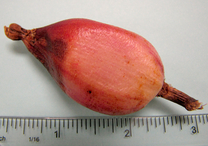 , 2–6 mm long, obconicalobconical:
, 2–6 mm long, obconicalobconical:
3D shape—inversely cone-shaped, with point of attachment at narrow end
or trigonoustrigonous:
3D shape—having three faces that meet at distinct angles; triangular in outline
, prominently to obscurely 3-angled in transection, with two or several seeds (Campynemanthe) or many seeds (Campynema), with tepalstepal:
a member of the perianth, when it cannot be differentiated into a calyx and corolla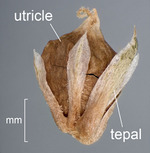 persistent near apexapex:
persistent near apexapex:
the point farthest from the point of attachment, or the "tip" of an organ . Pericarppericarp:
. Pericarppericarp:
fruit wall or fruit coat
membranousmembranous:
texture—extremely thin, pliable, and fairly tough
, ribbedribbed:
surface relief—wide, prominent, linear ridges that are generally rounded and longitudinally situated on the surface .
.
Seeds globoseglobose:
3D shape—more or less spherical to angularangular:
to angularangular:
2D shape—having sides that meet at acute or obtuse angles
in Campynemanthe with long persistent funiculifuniculus:
(alt. funicle) stalk connecting the ovule (later seed) to the ovary (later fruit) placenta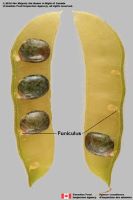 . Seeds compressedcompressed:
. Seeds compressedcompressed:
flattened; in grasses, used to denote compression (not necessarily flattened) either laterally or dorsiventrally
and nearly discoiddiscoid:
3D shape—resembling a disc
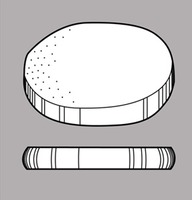 with a spongyspongy:
with a spongyspongy:
soft, light, discontinuous but cohesive, and somewhat resilient
seed coat in Campynema. Seeds 1–2 mm long. Seed coat pale red-brown, reticulatereticulate:
surface relief—netted, raised walls or concave grooves forming a net-like surface pattern with flat, concave, or convex interspaces .
.
Embryo minute.
Endosperm copious.
| Fruit | |
| Type | ventricidal capsulecapsule: a dry, dehiscent fruit derived from a compound ovary  |
| Size range | 2–6 mm long |
| Shape(s) | obconicalobconical: 3D shape—inversely cone-shaped, with point of attachment at narrow end , trigonoustrigonous: 3D shape—having three faces that meet at distinct angles; triangular in outline |
| Texture | membranousmembranous: texture—extremely thin, pliable, and fairly tough |
| Surface relief | ribbedribbed: surface relief—wide, prominent, linear ridges that are generally rounded and longitudinally situated on the surface  |
| Unique features | Small, membranousmembranous: texture—extremely thin, pliable, and fairly tough , ribbedribbed: surface relief—wide, prominent, linear ridges that are generally rounded and longitudinally situated on the surface  , ventricidal capsulescapsule: , ventricidal capsulescapsule:a dry, dehiscent fruit derived from a compound ovary  with persistent tepalstepal: with persistent tepalstepal:a member of the perianth, when it cannot be differentiated into a calyx and corolla  and small seeds with minute embryos. and small seeds with minute embryos. |
| Seed | |
| Size range | 1–2 mm long |
| Shape(s) | globoseglobose: 3D shape—more or less spherical  to angularangular: to angularangular:2D shape—having sides that meet at acute or obtuse angles or discoiddiscoid: 3D shape—resembling a disc  |
| Surface relief | reticulatereticulate: surface relief—netted, raised walls or concave grooves forming a net-like surface pattern with flat, concave, or convex interspaces  |
| Color(s) | pale red-brown |
| Unique features | Small, globoseglobose: 3D shape—more or less spherical  to angularangular: to angularangular:2D shape—having sides that meet at acute or obtuse angles seeds with long persistent funiculifuniculus: (alt. funicle) stalk connecting the ovule (later seed) to the ovary (later fruit) placenta  . Or, small discoiddiscoid: . Or, small discoiddiscoid:3D shape—resembling a disc  seeds with spongyspongy: seeds with spongyspongy:soft, light, discontinuous but cohesive, and somewhat resilient seed coats. |
| Other | |
| Embryo | minute |
| Nutritive tissue | endosperm copious |
New Caledonia (Campynemanthe), Tasmania (Campynema).
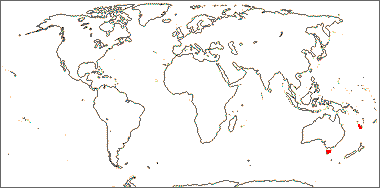
Distribution map courtesy of Angiosperm Phylogeny Website.
Baskin and Baskin 2021Baskin and Baskin 2021:
Baskin C and Baskin J. 2021. Relationship of the lateral embryo (in grasses) to other monocot embryos: A status up-grade. Seed Science Research 31 (3): 199-210. doi:10.1017/S0960258521000209; Dahlgren and Lu 1985Dahlgren and Lu 1985:
Dahlgren RMT and Lu AM. 1985. Campynemanthe (Campynemaceae): morphology, microsporogenesis, early ovule ontogeny and relationships. Nordic Journal of Botany 5: 321-330.; Dahlgren et al. 1985Dahlgren et al. 1985:
Dahlgren RMT, Clifford HT, and Yeo PF. 1985. The families of the monocotyledons: structure, evolution, and taxonomy. Springer-Verlag, Berlin. 520 pp.; Flora of Australia 2021+Flora of Australia 2021+:
Flora of Australia. Australian Biological Resources Study, Canberra. Accessed January 2021–March 2024. URL: http://www.ausflora.org.au; Kirkbride et al. 2006Kirkbride et al. 2006:
Kirkbride JH, Jr, Gunn CR, and Dallwitz MJ. 2006. Family guide for fruits and seeds, vers. 1.0. Accessed September 2020-January 2022. URL: https://nt.ars-grin.gov/seedsfruits/keys/frsdfam/index.cfm .; Kubitzki et al. 1990+Kubitzki et al. 1990+:
Kubitzki K et al., eds. 1990+. The families and genera of vascular plants. 7+ vols. Berlin etc.; Lowry II et al. 1987Lowry II et al. 1987:
Lowry II PP, Goldblatt P, and Tobe H. 1987. Notes on the Floral Biology, Cytology, and Embryology of Campynemanthe (Liliales: Campynemataceae). Annals of the Missouri Botanical Garden 74: 573-576.; Stevenson and Loconte 1995Stevenson and Loconte 1995:
Stevenson DW and Loconte H. 1995. A cladistic analysis of monocot families. In: Rudall PJ, Cribb PJ, Cutler DF, and Humphries CJ, eds. Monocotyledons: Systematics and Evolution. Royal Botanic Gardens, Kew.; Watson and Dallwitz 1992+Watson and Dallwitz 1992+:
Watson L and Dallwitz MJ. 1992+. The families of flowering plants: descriptions, illustrations, identification, and information retrieval. Version: 6th Accessed September 2020-September 2022. URL: delta-intkey.com
*The number of genera and species is based on Christenhusz and Byng 2016Christenhusz and Byng 2016:
Christenhusz MJM and Byng JW. 2016. The number of known plant species in the world and its annual increase. Phytotaxa 261 (3): 201-217. https://doi.org/10.11646/phytotaxa.261.3.1, which may differ from the number of genera in GRIN-Global.